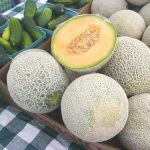
Mulching: Improving honeydew melon growth
Mulching is one of the simplest and most beneficial management practices that could improve the moisture and consistency of soil. As is it easy to do, mulching is inexpensive and does not require much effort. Mulching refers to the spreading of materials on the surface of the soil as protective layers, whether organic or inorganic, loose particles or sheets. Generally, mulching is used to protect the soil from erosion, reduce compaction from the impact of heavy rains, conserve moisture, reduce the need for frequent watering, maintain soil temperature, and prevent weed growth. In this manner, mulching could improve off-season production of honeydew melon. Previous studies conducted involving other fruits showed that mulching could promote early plant development, increase yield, and enhance quality of produce.Mulching materials
Mulching materials could be either organic or inorganic. Among some of the most common inorganic mulching and row cover materials are plastic. Studies showed that this type of mulching materials could modify the microclimate of plants and effectively improve plant growth. Likewise, the rise in air and soil temperature increases the flowers of watermelon. For this particular study, three mulching materials were used: reflectorized polyethylene plastic (PEPrs), #50 black nonwomen fabric (NWFb), and rice straw. For the row covers, Aquino and Mabesa used 0.076 mm clear plyethylene (PEPc), #17 white woven fabric (NWFw), and white nylon net. To determine the effectivity of the different mulch materials used, the researchers used five parameters: effect on microclimate, soil chemical properties, pest incidence, yield, and horticultural characteristics.Ideal mulch and row cover
Results of the study showed that among the mulch materials used, polyethylene (PEP) proved to be the most advantageous and effective. Specifically, mulching with the reflectorized polyethylene plastic and clear polythylene (PEPc) and white nonwoven fabric (NWFw) as row cover increased the soil temperature and produced better nutrient uptake. There was also an increased in growth and flowering. More female flowers matured earlier than expected. The insect and pest disease incidence were lesser. The fruit quality was better and the yield was higher compared to other melons under study. Using the rice straw as mulch in combination with the non woven fabric as row cover also gave a favorable results but not as effective as the polyethylene. Meanwhile mulching with rice straw alone resulted in highest arthropod pest infestation and diseases incidence due to the harboring of thrips and mites. It gained the highest air temperature and soil moisture retention, which are conditions suited for microbial growth. Nevertheless, using rice straw provided a few benefit. A notable increased in soil phosphorus, potassium and cation exchange capacity were observed after the cropping. The use of nylon net as row cover allowed light to penetrate into the canopy thus resulting in the lowest air temperature due of its porus nature. Researchers concluded that nylon net is not as effective as the polyethelene or the nonwoven fabric as row covers.----------------------------------------- Source: Year-round production of small potted flowering Mussaenda through off-season production of flowering shoot by Primitivo Jose Santos, Calixto Protacio and Reynold Pimentel of the Institute of Plant Breeding, College of Agriculture (IPB-CA) in the University of the Philippines at Los Baños (UPLB)
By: Rita T. De la Cruz, BAR Digest, October-December 2003 Issue (Vol. 5 No. 4)
Source: Business Diary Philippines



0 Comments